2015 CHEVROLET CITY EXPRESS stop start
[x] Cancel search: stop startPage 154 of 297
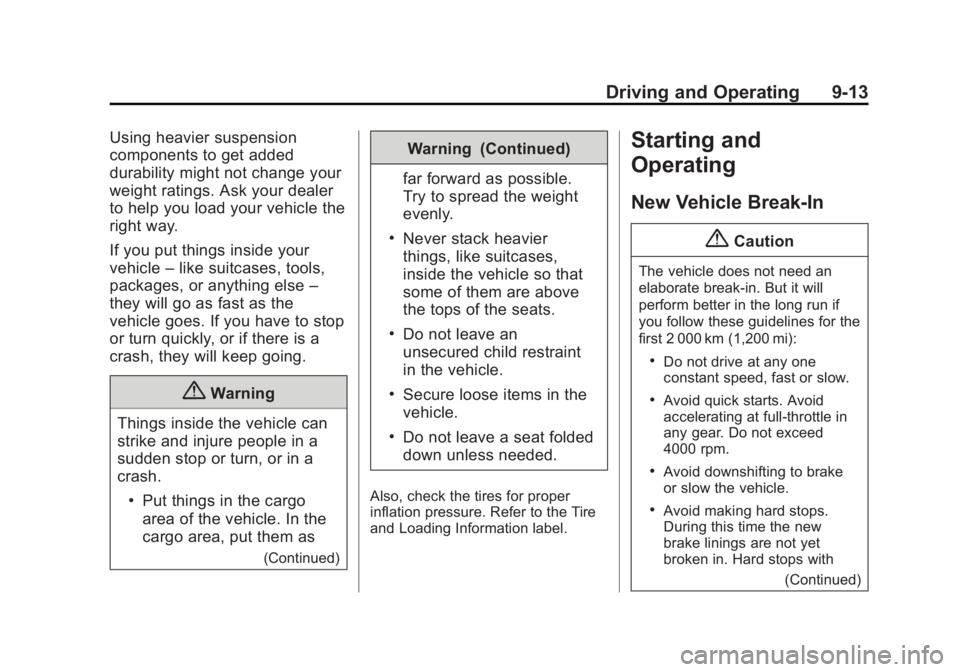
Black plate (13,1)Chevrolet City Express Owner Manual (GMNA-Localizing-U.S./Canada-
7707496) - 2015 - CRC - 11/26/14
Driving and Operating 9-13Using heavier suspension
components to get added
durability might not change your
weight ratings. Ask your dealer
to help you load your vehicle the
right way.
If you put things inside your
vehicle – like suitcases, tools,
packages, or anything else –
they will go as fast as the
vehicle goes. If you have to stop
or turn quickly, or if there is a
crash, they will keep going.
{ Warning
Things inside the vehicle can
strike and injure people in a
sudden stop or turn, or in a
crash. .
Put things in the cargo
area of the vehicle. In the
cargo area, put them as
(Continued) Warning (Continued)
far forward as possible.
Try to spread the weight
evenly. .
Never stack heavier
things, like suitcases,
inside the vehicle so that
some of them are above
the tops of the seats. .
Do not leave an
unsecured child restraint
in the vehicle. .
Secure loose items in the
vehicle. .
Do not leave a seat folded
down unless needed.
Also, check the tires for proper
inflation pressure. Refer to the Tire
and Loading Information label. Starting and
Operating New Vehicle Break-In
{ CautionThe vehicle does not need an
elaborate break-in. But it will
perform better in the long run if
you follow these guidelines for the
first 2 000 km (1,200 mi): .
Do not drive at any one
constant speed, fast or slow. .
Avoid quick starts. Avoid
accelerating at full-throttle in
any gear. Do not exceed
4000 rpm. .
Avoid downshifting to brake
or slow the vehicle. .
Avoid making hard stops.
During this time the new
brake linings are not yet
broken in. Hard stops with
(Continued)
Page 156 of 297
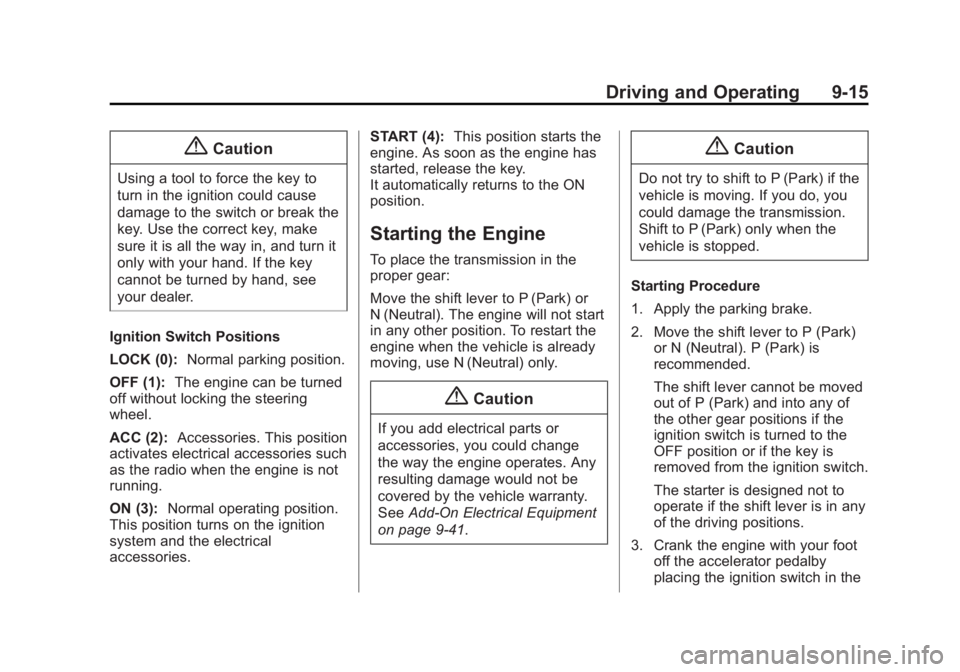
Black plate (15,1)Chevrolet City Express Owner Manual (GMNA-Localizing-U.S./Canada-
7707496) - 2015 - CRC - 11/26/14
Driving and Operating 9-15
{ CautionUsing a tool to force the key to
turn in the ignition could cause
damage to the switch or break the
key. Use the correct key, make
sure it is all the way in, and turn it
only with your hand. If the key
cannot be turned by hand, see
your dealer.
Ignition Switch Positions
LOCK (0): Normal parking position.
OFF (1): The engine can be turned
off without locking the steering
wheel.
ACC (2): Accessories. This position
activates electrical accessories such
as the radio when the engine is not
running.
ON (3): Normal operating position.
This position turns on the ignition
system and the electrical
accessories. START (4): This position starts the
engine. As soon as the engine has
started, release the key.
It automatically returns to the ON
position.
Starting the Engine To place the transmission in the
proper gear:
Move the shift lever to P (Park) or
N (Neutral). The engine will not start
in any other position. To restart the
engine when the vehicle is already
moving, use N (Neutral) only.
{ Caution
If you add electrical parts or
accessories, you could change
the way the engine operates. Any
resulting damage would not be
covered by the vehicle warranty.
See Add-On Electrical Equipment
on page 9-41 .{ CautionDo not try to shift to P (Park) if the
vehicle is moving. If you do, you
could damage the transmission.
Shift to P (Park) only when the
vehicle is stopped.
Starting Procedure
1. Apply the parking brake.
2. Move the shift lever to P (Park)
or N (Neutral). P (Park) is
recommended.
The shift lever cannot be moved
out of P (Park) and into any of
the other gear positions if the
ignition switch is turned to the
OFF position or if the key is
removed from the ignition switch.
The starter is designed not to
operate if the shift lever is in any
of the driving positions.
3. Crank the engine with your foot
off the accelerator pedalby
placing the ignition switch in the
Page 157 of 297
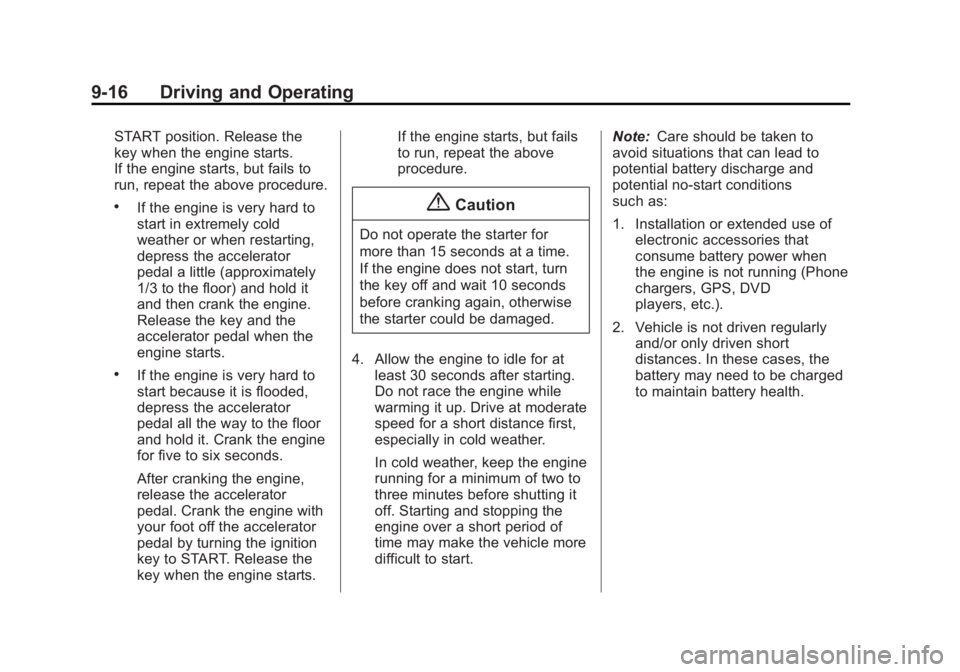
Black plate (16,1)Chevrolet City Express Owner Manual (GMNA-Localizing-U.S./Canada-
7707496) - 2015 - CRC - 11/26/14
9-16 Driving and Operating START position. Release the
key when the engine starts.
If the engine starts, but fails to
run, repeat the above procedure. .
If the engine is very hard to
start in extremely cold
weather or when restarting,
depress the accelerator
pedal a little (approximately
1/3 to the floor) and hold it
and then crank the engine.
Release the key and the
accelerator pedal when the
engine starts. .
If the engine is very hard to
start because it is flooded,
depress the accelerator
pedal all the way to the floor
and hold it. Crank the engine
for five to six seconds.
After cranking the engine,
release the accelerator
pedal. Crank the engine with
your foot off the accelerator
pedal by turning the ignition
key to START. Release the
key when the engine starts. If the engine starts, but fails
to run, repeat the above
procedure.
{ CautionDo not operate the starter for
more than 15 seconds at a time.
If the engine does not start, turn
the key off and wait 10 seconds
before cranking again, otherwise
the starter could be damaged.
4. Allow the engine to idle for at
least 30 seconds after starting.
Do not race the engine while
warming it up. Drive at moderate
speed for a short distance first,
especially in cold weather.
In cold weather, keep the engine
running for a minimum of two to
three minutes before shutting it
off. Starting and stopping the
engine over a short period of
time may make the vehicle more
difficult to start. Note: Care should be taken to
avoid situations that can lead to
potential battery discharge and
potential no-start conditions
such as:
1. Installation or extended use of
electronic accessories that
consume battery power when
the engine is not running (Phone
chargers, GPS, DVD
players, etc.).
2. Vehicle is not driven regularly
and/or only driven short
distances. In these cases, the
battery may need to be charged
to maintain battery health.
Page 160 of 297
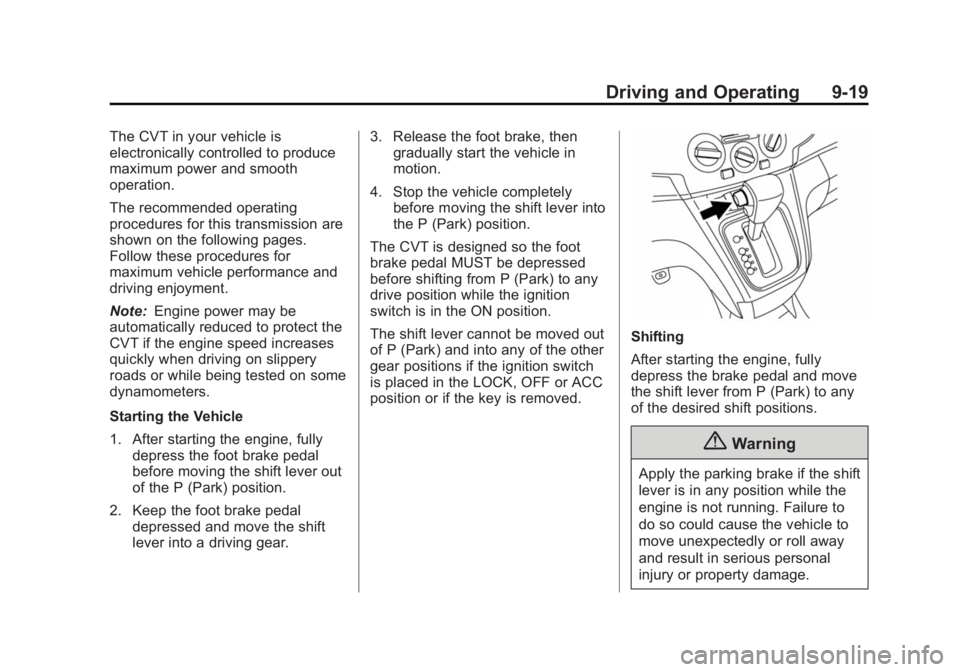
Black plate (19,1)Chevrolet City Express Owner Manual (GMNA-Localizing-U.S./Canada-
7707496) - 2015 - CRC - 11/26/14
Driving and Operating 9-19The CVT in your vehicle is
electronically controlled to produce
maximum power and smooth
operation.
The recommended operating
procedures for this transmission are
shown on the following pages.
Follow these procedures for
maximum vehicle performance and
driving enjoyment.
Note: Engine power may be
automatically reduced to protect the
CVT if the engine speed increases
quickly when driving on slippery
roads or while being tested on some
dynamometers.
Starting the Vehicle
1. After starting the engine, fully
depress the foot brake pedal
before moving the shift lever out
of the P (Park) position.
2. Keep the foot brake pedal
depressed and move the shift
lever into a driving gear. 3. Release the foot brake, then
gradually start the vehicle in
motion.
4. Stop the vehicle completely
before moving the shift lever into
the P (Park) position.
The CVT is designed so the foot
brake pedal MUST be depressed
before shifting from P (Park) to any
drive position while the ignition
switch is in the ON position.
The shift lever cannot be moved out
of P (Park) and into any of the other
gear positions if the ignition switch
is placed in the LOCK, OFF or ACC
position or if the key is removed. Shifting
After starting the engine, fully
depress the brake pedal and move
the shift lever from P (Park) to any
of the desired shift positions.
{ Warning
Apply the parking brake if the shift
lever is in any position while the
engine is not running. Failure to
do so could cause the vehicle to
move unexpectedly or roll away
and result in serious personal
injury or property damage.
Page 161 of 297
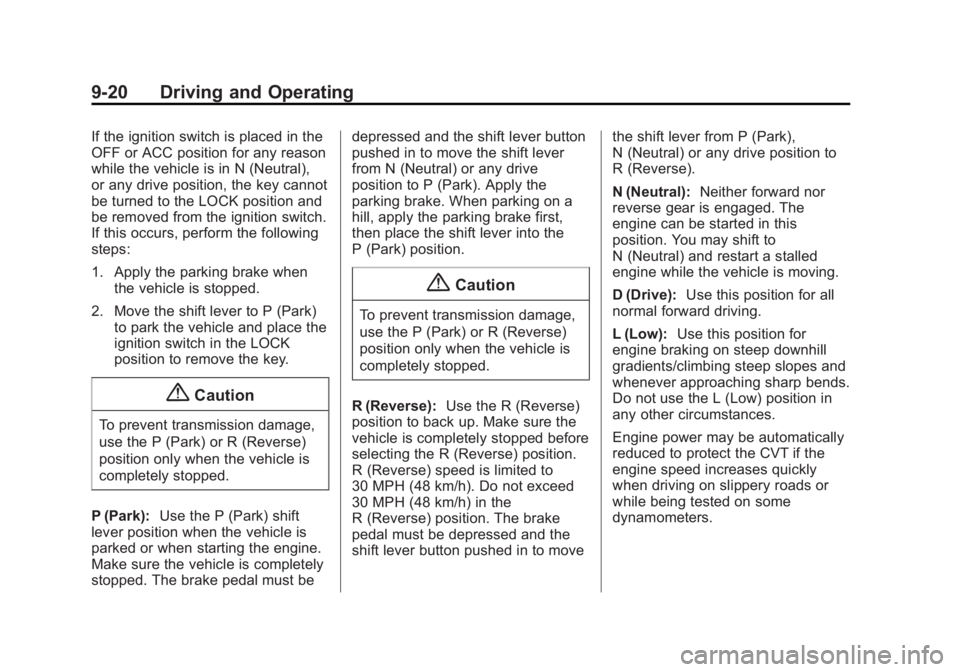
Black plate (20,1)Chevrolet City Express Owner Manual (GMNA-Localizing-U.S./Canada-
7707496) - 2015 - CRC - 11/26/14
9-20 Driving and Operating If the ignition switch is placed in the
OFF or ACC position for any reason
while the vehicle is in N (Neutral),
or any drive position, the key cannot
be turned to the LOCK position and
be removed from the ignition switch.
If this occurs, perform the following
steps:
1. Apply the parking brake when
the vehicle is stopped.
2. Move the shift lever to P (Park)
to park the vehicle and place the
ignition switch in the LOCK
position to remove the key.
{ Caution
To prevent transmission damage,
use the P (Park) or R (Reverse)
position only when the vehicle is
completely stopped.
P (Park): Use the P (Park) shift
lever position when the vehicle is
parked or when starting the engine.
Make sure the vehicle is completely
stopped. The brake pedal must be depressed and the shift lever button
pushed in to move the shift lever
from N (Neutral) or any drive
position to P (Park). Apply the
parking brake. When parking on a
hill, apply the parking brake first,
then place the shift lever into the
P (Park) position.
{ CautionTo prevent transmission damage,
use the P (Park) or R (Reverse)
position only when the vehicle is
completely stopped.
R (Reverse): Use the R (Reverse)
position to back up. Make sure the
vehicle is completely stopped before
selecting the R (Reverse) position.
R (Reverse) speed is limited to
30 MPH (48 km/h). Do not exceed
30 MPH (48 km/h) in the
R (Reverse) position. The brake
pedal must be depressed and the
shift lever button pushed in to move the shift lever from P (Park),
N (Neutral) or any drive position to
R (Reverse).
N (Neutral): Neither forward nor
reverse gear is engaged. The
engine can be started in this
position. You may shift to
N (Neutral) and restart a stalled
engine while the vehicle is moving.
D (Drive): Use this position for all
normal forward driving.
L (Low): Use this position for
engine braking on steep downhill
gradients/climbing steep slopes and
whenever approaching sharp bends.
Do not use the L (Low) position in
any other circumstances.
Engine power may be automatically
reduced to protect the CVT if the
engine speed increases quickly
when driving on slippery roads or
while being tested on some
dynamometers.
Page 163 of 297
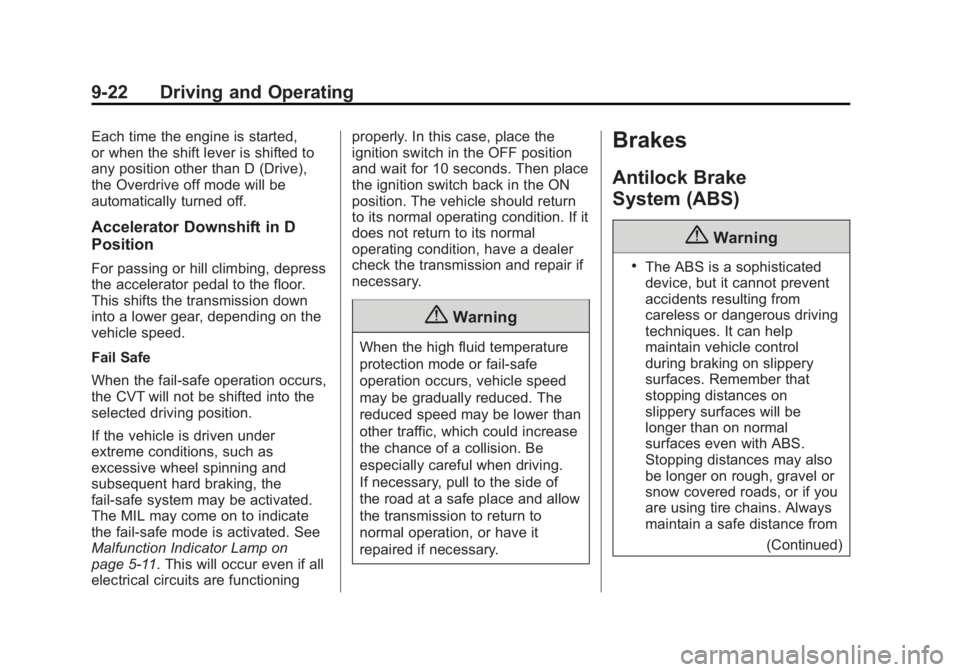
Black plate (22,1)Chevrolet City Express Owner Manual (GMNA-Localizing-U.S./Canada-
7707496) - 2015 - CRC - 11/26/14
9-22 Driving and Operating Each time the engine is started,
or when the shift lever is shifted to
any position other than D (Drive),
the Overdrive off mode will be
automatically turned off.
Accelerator Downshift in D
Position For passing or hill climbing, depress
the accelerator pedal to the floor.
This shifts the transmission down
into a lower gear, depending on the
vehicle speed.
Fail Safe
When the fail-safe operation occurs,
the CVT will not be shifted into the
selected driving position.
If the vehicle is driven under
extreme conditions, such as
excessive wheel spinning and
subsequent hard braking, the
fail-safe system may be activated.
The MIL may come on to indicate
the fail-safe mode is activated. See
Malfunction Indicator Lamp on
page 5-11 . This will occur even if all
electrical circuits are functioning properly. In this case, place the
ignition switch in the OFF position
and wait for 10 seconds. Then place
the ignition switch back in the ON
position. The vehicle should return
to its normal operating condition. If it
does not return to its normal
operating condition, have a dealer
check the transmission and repair if
necessary.
{ WarningWhen the high fluid temperature
protection mode or fail-safe
operation occurs, vehicle speed
may be gradually reduced. The
reduced speed may be lower than
other traffic, which could increase
the chance of a collision. Be
especially careful when driving.
If necessary, pull to the side of
the road at a safe place and allow
the transmission to return to
normal operation, or have it
repaired if necessary. Brakes Antilock Brake
System (ABS)
{ Warning .
The ABS is a sophisticated
device, but it cannot prevent
accidents resulting from
careless or dangerous driving
techniques. It can help
maintain vehicle control
during braking on slippery
surfaces. Remember that
stopping distances on
slippery surfaces will be
longer than on normal
surfaces even with ABS.
Stopping distances may also
be longer on rough, gravel or
snow covered roads, or if you
are using tire chains. Always
maintain a safe distance from
(Continued)
Page 195 of 297
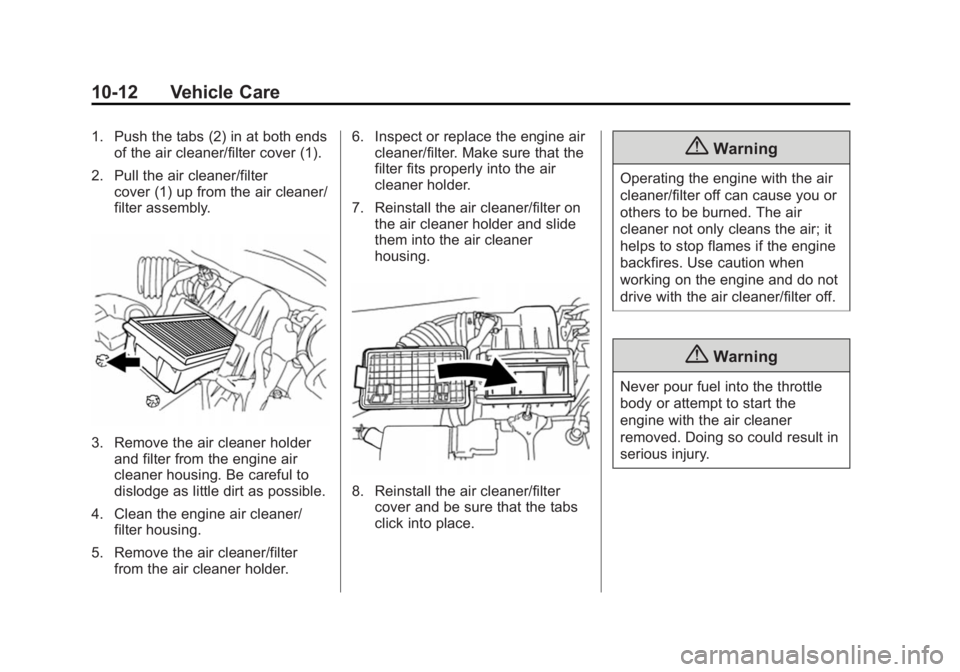
Black plate (12,1)Chevrolet City Express Owner Manual (GMNA-Localizing-U.S./Canada-
7707496) - 2015 - CRC - 11/26/14
10-12 Vehicle Care 1. Push the tabs (2) in at both ends
of the air cleaner/filter cover (1).
2. Pull the air cleaner/filter
cover (1) up from the air cleaner/
filter assembly.
3. Remove the air cleaner holder
and filter from the engine air
cleaner housing. Be careful to
dislodge as little dirt as possible.
4. Clean the engine air cleaner/
filter housing.
5. Remove the air cleaner/filter
from the air cleaner holder. 6. Inspect or replace the engine air
cleaner/filter. Make sure that the
filter fits properly into the air
cleaner holder.
7. Reinstall the air cleaner/filter on
the air cleaner holder and slide
them into the air cleaner
housing.
8. Reinstall the air cleaner/filter
cover and be sure that the tabs
click into place. { WarningOperating the engine with the air
cleaner/filter off can cause you or
others to be burned. The air
cleaner not only cleans the air; it
helps to stop flames if the engine
backfires. Use caution when
working on the engine and do not
drive with the air cleaner/filter off.
{ WarningNever pour fuel into the throttle
body or attempt to start the
engine with the air cleaner
removed. Doing so could result in
serious injury.
Page 207 of 297
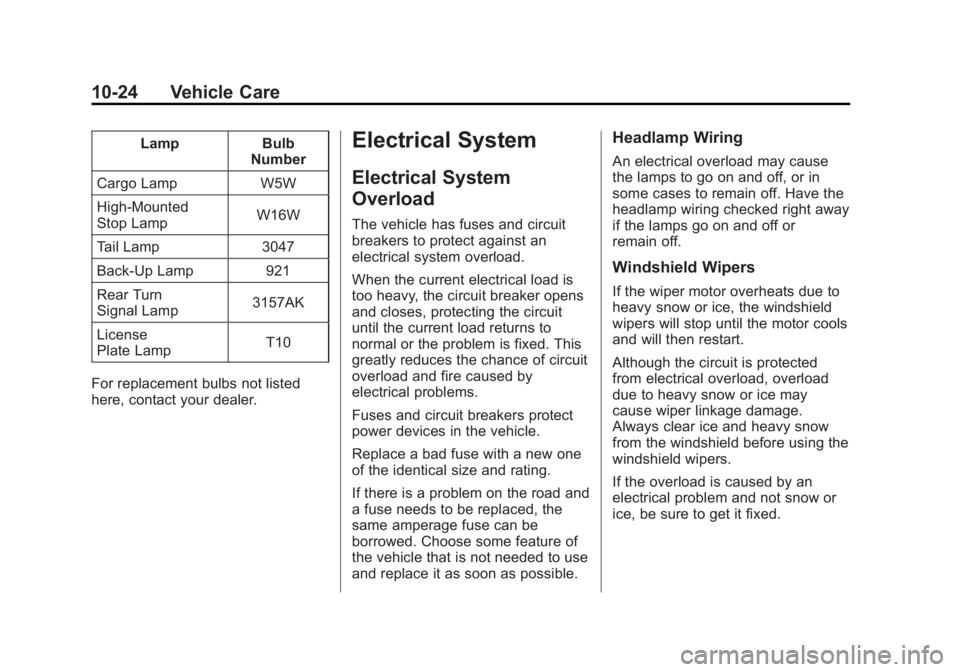
Black plate (24,1)Chevrolet City Express Owner Manual (GMNA-Localizing-U.S./Canada-
7707496) - 2015 - CRC - 11/26/14
10-24 Vehicle Care Lamp Bulb
Number
Cargo Lamp W5W
High-Mounted
Stop Lamp W16W
Tail Lamp 3047
Back-Up Lamp 921
Rear Turn
Signal Lamp 3157AK
License
Plate Lamp T10
For replacement bulbs not listed
here, contact your dealer. Electrical System Electrical System
Overload The vehicle has fuses and circuit
breakers to protect against an
electrical system overload.
When the current electrical load is
too heavy, the circuit breaker opens
and closes, protecting the circuit
until the current load returns to
normal or the problem is fixed. This
greatly reduces the chance of circuit
overload and fire caused by
electrical problems.
Fuses and circuit breakers protect
power devices in the vehicle.
Replace a bad fuse with a new one
of the identical size and rating.
If there is a problem on the road and
a fuse needs to be replaced, the
same amperage fuse can be
borrowed. Choose some feature of
the vehicle that is not needed to use
and replace it as soon as possible. Headlamp Wiring An electrical overload may cause
the lamps to go on and off, or in
some cases to remain off. Have the
headlamp wiring checked right away
if the lamps go on and off or
remain off.
Windshield Wipers If the wiper motor overheats due to
heavy snow or ice, the windshield
wipers will stop until the motor cools
and will then restart.
Although the circuit is protected
from electrical overload, overload
due to heavy snow or ice may
cause wiper linkage damage.
Always clear ice and heavy snow
from the windshield before using the
windshield wipers.
If the overload is caused by an
electrical problem and not snow or
ice, be sure to get it fixed.